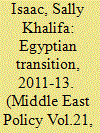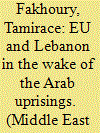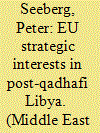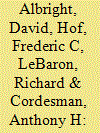|
|
|
Sort Order |
|
|
|
Items / Page
|
|
|
|
|
|
|
| Srl | Item |
| 1 |
ID:
130942


|
|
|
|
|
| Publication |
2014.
|
| Summary/Abstract |
This paper tackles the political and security complications of the Egyptian transition from its inception in January 2011 until the fall of the Muslim Brotherhood president, Mohamed Morsi, in July 2013, with a primary focus on how these complications are of strategic importance to Europe. It starts with inferring Egypt's role in European Union (EU) approaches to security in the Mediterranean, which were acknowledged in the 2003 European Security Strategy and then largely interpreted in the 2004 European Neighborhood Policy. It argues that the old EU democracy-stability dilemma persisted in Europe's approach to the Egyptian transition, especially during Morsi's one-year presidency. In discussing the current political and security complications of the Egyptian transition and how they constitute strategic concerns to Europe, the analysis tackles undermined social cohesion in Egypt due to processes of repolarization in Egyptian society after July 2013; the question of Egypt's porous borders with the Hamas-controlled Gaza Strip; the emergence of the Sinai Peninsula as a jihadist center; and the rising importance of economics in the EU-Egyptian relationship
|
|
|
|
|
|
|
|
|
|
|
|
|
|
|
|
| 2 |
ID:
130940


|
|
|
|
|
| Publication |
2014.
|
| Summary/Abstract |
Lebanon is a multisectarian state in which Muslim and Christian groups share political power. The executive elite is composed of a Maronite president, a Shiite speaker of parliament and a Sunni prime minister. The legislature is split 50-50 between Muslims and Christians, and communities enjoy educational and religious autonomy. Two pacts act as regulatory frameworks for these political arrangements: the 1943 National Pact and the 1989 Taif agreement, which put a halt to Lebanon's 15-year civil war (1975-90).
While Lebanon's prewar political system (1943-75) was often framed as a paradigmatic case of consociational or power-sharing democracy,1 most observers today agree that this system is an anarchistic model for the devolution of power. 2 Sectarian3 politics feeds on patronage ties and foreign alliances through which communities vie for control over resources. It further reifies partisanship in external conflicts.
|
|
|
|
|
|
|
|
|
|
|
|
|
|
|
|
| 3 |
ID:
130939


|
|
|
|
|
| Publication |
2014.
|
| Summary/Abstract |
Since the fall of Muammar Qadhafi in 2011, a legitimate monopoly over the means of violence has not been in the hands of the Libyan state. The military confrontation between the regime and what the international media called the "rebels," supported by the NATO no-fly zone, ended in October 2011. However, in 2012 and especially in 2013, Libya witnessed an escalating conflict pitting the democratically elected government and the Libyan state against armed groups and militias. For the EU, this is a challenge to its strategic interests, primarily security in the Mediterranean and secondarily migration and the development of Libya.
|
|
|
|
|
|
|
|
|
|
|
|
|
|
|
|
| 4 |
ID:
130941


|
|
|
|
|
| Publication |
2014.
|
| Summary/Abstract |
The Arab Spring may have begun in Tunisia in December 2010 with mass protests that ultimately toppled the regime of Zine El Abidin Ben Ali, but that same month, protesters also gathered in Amman's streets, demanding political change. The Jordanian demonstrations were never as large as those in Tunisia and were certainly not comparable to the mass protest rallies in Egypt's Tahrir Square. They also differed in focus, calling for reform but not for regime change or revolution. Initially, they demanded the ouster of the government of Prime Minister Samir Rifai, and succeeded. But even after the shift in royally appointed governments, protesters continued to gather almost every Friday for the next several years, calling for more reform within the Hashemite Kingdom
|
|
|
|
|
|
|
|
|
|
|
|
|
|
|
|
| 5 |
ID:
130931


|
|
|
|
|
| Publication |
2014.
|
| Summary/Abstract |
In my 40 years in the region, I can't remember so many big front-page issues. Egypt, Syria, Iraq, Afghanistan and Iran. All are major problems at the same time, and there are lots of doubts about the U.S. role. Traditional allies are expressing concern and in some cases anger, wondering if the United States is actually a reliable ally. Today's topic lies at the heart of many of these concerns. We are very fortunate to have with us today a panel of true Middle East experts who have real-time, on-the-ground experience in the region.
|
|
|
|
|
|
|
|
|
|
|
|
|
|
|
|
|
|
|
|
|